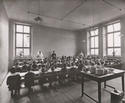 This period is dominated by the two major conflicts of the 20th century. Nevertheless grave concern over the diet of the working class in Glasgow in the opening decade of the 20th century had not been addressed in a concerted way. The School Meals Act in 1906 had done something to address nutrition of the children of poorer communities. By 1914 200,000 children were benefiting from the scheme. Yet Forces recruitment criteria were difficult to satisfy in Glasgow until "bantam" regiments were raised from those below the minima.
This period is dominated by the two major conflicts of the 20th century. Nevertheless grave concern over the diet of the working class in Glasgow in the opening decade of the 20th century had not been addressed in a concerted way. The School Meals Act in 1906 had done something to address nutrition of the children of poorer communities. By 1914 200,000 children were benefiting from the scheme. Yet Forces recruitment criteria were difficult to satisfy in Glasgow until "bantam" regiments were raised from those below the minima.
 At the outbreak of war in 1914, no restrictions were placed on food supply for the first two years. By the middle of 1916 prices began to rise and there were complaints of profiteering. In the spring of 1917, the German U-boat campaign had become a serious threat and the food stocks of the nation had been reduced to three weeks. However civilian rationing did not start until January 1918, after much administrative muddle, with sugar only. In April this was extended to butter, jam, tea, bacon and fresh meat. Bread and potatoes were not included. Provision of factory canteens on a vast scale benefited the civilian population greatly.
At the outbreak of war in 1914, no restrictions were placed on food supply for the first two years. By the middle of 1916 prices began to rise and there were complaints of profiteering. In the spring of 1917, the German U-boat campaign had become a serious threat and the food stocks of the nation had been reduced to three weeks. However civilian rationing did not start until January 1918, after much administrative muddle, with sugar only. In April this was extended to butter, jam, tea, bacon and fresh meat. Bread and potatoes were not included. Provision of factory canteens on a vast scale benefited the civilian population greatly.
 During the inter-war years imported chilled meat, butter, canned goods and bulk grain brought prices down and items previously considered luxuries became more widely available. Branded goods, embryonic before the war, became more commonplace, OXO, Bovril, Kellogg's, Heinz, Crosse & Blackwell and many others becoming well known. New research into nutrition and discovery of vitamins made people conscious of healthy eating. But during the Depression of the 1930s, those on low incomes or unemployment benefit experienced considerable privation on diets dominated by bread, margarine, tea and potatoes.
During the inter-war years imported chilled meat, butter, canned goods and bulk grain brought prices down and items previously considered luxuries became more widely available. Branded goods, embryonic before the war, became more commonplace, OXO, Bovril, Kellogg's, Heinz, Crosse & Blackwell and many others becoming well known. New research into nutrition and discovery of vitamins made people conscious of healthy eating. But during the Depression of the 1930s, those on low incomes or unemployment benefit experienced considerable privation on diets dominated by bread, margarine, tea and potatoes.
 Following outbreak of war in 1939, rationing plans were introduced on 8 January 1940. It was similar to the German system, but its strength was fairness with a "guaranteed" ration of fats, sugar, meat, etc for all. A selection of unrationed foods, including bread and vegetables and a "points" system for luxuries varied the pattern of eating. Black marketeering occurred, but the system guaranteed a nutritious, if dull, diet. Nutritional health improved during World War Two and many families in the poorest of circumstances had entitlement to foods previously beyond their means. The system was retained after the War and became more stringent in the late 1940s when poor wheat harvests necessitated bread going on ration. Rationing was not totally repealed until 1954.
Following outbreak of war in 1939, rationing plans were introduced on 8 January 1940. It was similar to the German system, but its strength was fairness with a "guaranteed" ration of fats, sugar, meat, etc for all. A selection of unrationed foods, including bread and vegetables and a "points" system for luxuries varied the pattern of eating. Black marketeering occurred, but the system guaranteed a nutritious, if dull, diet. Nutritional health improved during World War Two and many families in the poorest of circumstances had entitlement to foods previously beyond their means. The system was retained after the War and became more stringent in the late 1940s when poor wheat harvests necessitated bread going on ration. Rationing was not totally repealed until 1954.